- Home
- »
- Advanced Interior Materials
- »
-
Chillers Market Size, Share, Growth & Trends Report, 2030GVR Report cover
![Chillers Market Size, Share & Trends Report]()
Chillers Market Size, Share & Trends Analysis Report By Product, By Application, By Compressor Type (Screw Chillers, Centrifugal Chillers, Absorption Chillers, Scroll Chillers, Reciprocating Chillers), By Region, And Segment Forecasts, 2024 - 2030
- Report ID: GVR-4-68038-923-4
- Number of Report Pages: 205
- Format: PDF, Horizon Databook
- Historical Range: 2018 - 2022
- Forecast Period: 2023 - 2030
- Industry: Advanced Materials
Chillers Market Size & Trends
The global chillers market size was estimated at USD 9,928.3 million in 2023 and is projected to grow at a compound annual growth rate (CAGR) of 4.5% from 2024 to 2030. The market is driven by the rising need for cost-effective and energy-efficient space cooling solutions in commercial and industrial sectors. This, in turn, is expected to augment the demand for the chillers market over the forecast period.
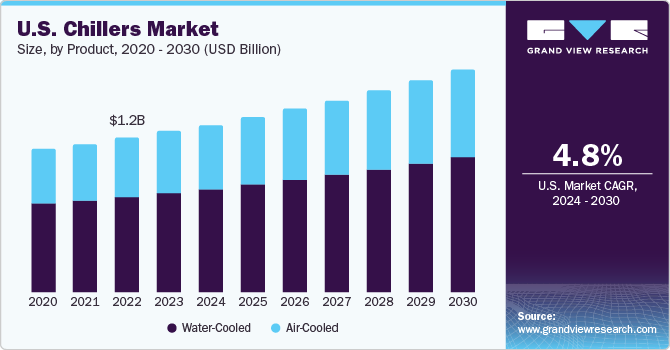
According to the U.S. Department of Agriculture (USDA), the growing population, rising consumer disposable income, and ongoing urbanization are expected to augment the growth of commercial and residential sector in the country in the forecast period. The demand for chillers in the U.S. residential sectors is driven by a combination of factors, including the need for efficient and reliable air conditioning systems. With a focus on energy efficiency, homeowners are increasingly adopting chillers equipped with advanced technologies and smart controls to ensure precise temperature regulation while minimizing environmental impact. In the commercial sector, the demand for chillers remains robust, particularly in industries such as hospitality, healthcare, and data centres.
Moreover, chillers play a pivotal role in maintaining optimal temperatures for occupant comfort, equipment reliability, and critical processes. The trend towards sustainable building practices and stringent energy efficiency standards further accelerates the adoption of chillers in both residential and commercial applications across the U.S.
The integration of advanced technologies is transforming the global market. Smart chillers, equipped with IoT capabilities, sensors, and predictive maintenance features, allow for remote monitoring and optimization. These technologies enhance overall system efficiency, reduce downtime, and contribute to cost savings. These aforementioned factors are further expected to drive the demand for market over the forecast period.
Market Concentration & Characteristics
Market growth stage is medium, and pace of the market growth is accelerating. The chillers market is characterized by highly consolidated owing to presence of several established players, which makes it difficult for small-scale manufactures to compete with global players.
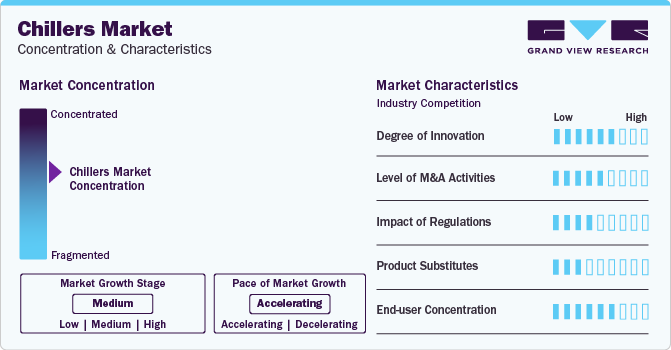
The market is also characterized by a high degree of product innovation, for instance, many manufacturers are developing chillers that use low GWP refrigerants, such as HFOs or natural refrigerants like CO2.
Chiller systems are becoming more intelligent and energy-efficient with advancements in technology. Product features such as energy efficiency, expandability, compact design, low environmental impact, and wireless technology are crucial for the product to succeed in the market.
End-user concentration is a significant factor in the market, owing to a huge number of commercial and industrial facilities that require chillers.
Product Insights
Based on product, the water-cooled chillers segment held the market with the largest revenue share of 59.8% in 2023, owing to its compact size, high energy-efficiency and long life. Water-cooled chillers offer a broad cooling capacity of 10-4,000 tons and are an excellent choice for indoor applications. They are best suited for various industrial applications with high thermal output. Water-cooled chillers can handle wide cooling loads, generally observed in chemical plants, manufacturing facilities, and medical facilities (such as laboratories and cleanrooms).
The demand for air-cooled chillers is expected to surge worldwide during the forecast period owing to their smooth operations at extremely low temperatures as these chillers eliminate the problems associated with the activity of cooling towers during the winter season. Moreover, increasing water scarcity across the world is anticipated to contribute to the demand for air-cooled chillers as they eliminate the requirement for water.
Application Insights
In terms of application, the commercial segment led the market with the largest revenue share of 48.6% in 2023. Chillers play a crucial role in commercial buildings by providing essential cooling effects. Their primary function is to counterbalance the heat accumulated from various internal and external sources. External factors, such as sunlight, wind, and outdoor temperature, contribute to heat gain, while internal influences include moisture from individuals, lighting, and heat generated by electrical or mechanical equipment. The advantages provided by chillers in managing these diverse factors within commercial spaces are expected to drive their demand in the forecast period.
In industrial applications, chillers play a vital role in managing and controlling temperatures for various processes and equipment. They are extensively employed in manufacturing facilities, chemical plants, and other industrial settings to cool machinery, control ambient temperatures, and ensure optimal conditions for production. Chillers contribute to process efficiency and product quality by preventing overheating, maintaining consistency in manufacturing processes, and facilitating precise temperature control.
Compressor Type Insights
Based on compressor type, the screw chillers segment led the market in 2023 with the largest revenue share of 49.6%. Screw chillers can be an air-cooled or water-cooled chillers depending on their functions and designs. They comprise two helical slot rotors, which compress refrigerant gases for cooling purposes. These chillers are used in applications that have high-power circulation requirements. Screw chillers are used in the chemicals, automotive, and printing industries.Moreover, they offer highly energy-efficient cooling capabilities required by industrial and commercial end users.
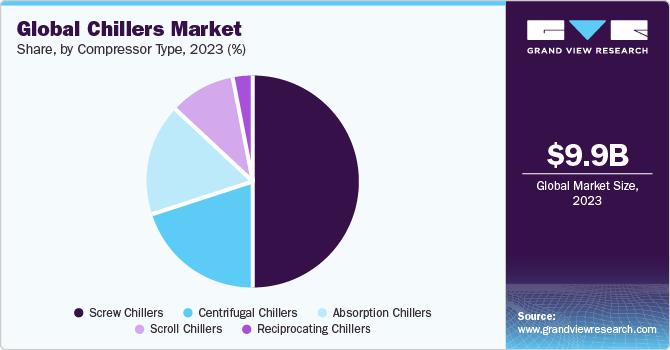
The primary application of centrifugal chillers is in the HVAC industry wherein the load requirements are between 300 tons and several thousand tons. Therefore, the growth of the HVAC industry across the world is expected to fuel the demand for centrifugal chillers. Key players in the market are actively focusing on new product launches to cater to the increasing demand for centrifugal chillers from the HVAC industry and fulfill the cooling requirements of various end-use applications.
Regional Insights
The Asia Pacific dominated the market with a revenue share of 45.5% in 2023. Asia Pacific region stands as the second-largest hub for data centers, driven by robust growth that not only enhances revenue but also generates fresh opportunities within the sector. The scale of data centers in Asia Pacific is expanding, with operators actively exploring new markets for potential expansion. This strategic move is in anticipation of rising demand fueled by ongoing digitization and the broader adoption of artificial intelligence. Factors such as improving economic conditions, rapid industrialization, and commercialization are anticipated to have a positive impact on the market growth.
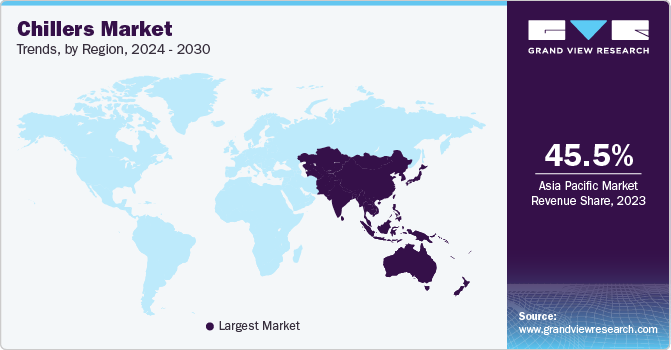
The growth of chillers in Central & South America is attributed to increasing investments in the public and private sectors, which is likely to drive the market over the forecast period. For instance, with the improving security conditions in metropolitan area with a market of 51.8 million people, Colombia remains an attractive destination for FDIs in Central & South America.
Key Chillers Company Insights
The global market is highly competitive on account of the presence of global and local manufacturers. Companies are engaged in expansion through mergers & acquisitions and joint ventures. These companies offer a wide range of systems that are sold through multiple channels, including distributors, company-owned websites, retailers & their websites, and e-commerce websites. For instance, in May 2023, Trane acquired MTA, an Italian manufacturer and distributor specializing in industrial refrigeration and air conditioning equipment. This strategic acquisition is expected to enhance Trane's commercial HVAC capabilities, particularly in key markets, by incorporating MTA's process chillers and expanding the rental and services business. With manufacturing sites located in Tribano and Conselve and a workforce of approximately 500 employees, MTA has an annual production capacity of 13,500 systems.
Key Chillers Companies:
The following are the leading companies in the chillers market. These companies collectively hold the largest market share and dictate industry trends. Financials, strategy maps & products of these chillers companies are analyzed to map the supply network.
- Trane
- Cold Shot Chillers
- Tandem Chillers
- Drake Refrigeration, Inc
- Refra
- Carrier
- FRIGEL FIRENZE S.p.A.
- Midea
- Daikin Industries, Ltd.
- Johnson Controls
- Rite-Temp
- General Air Products
- ClimaCool Corp.
- Fluid Chillers, Inc.
- Multistack International Limited
- Honeywell International, Inc.
Recent Developments
-
In December 2022, Trane unveiled its latest offerings, the water-cooled XStream eXcellent GVWF and air-cooled Sintesis eXcellent GVAF chillers. These innovative chillers incorporate magnetic-bearing compressors and utilize the low global warming potential (GWP) refrigerant R1234ze. Equipped with high-speed centrifugal compressor technology, these chillers deliver larger capacities, wider operating maps to meet challenging European climate conditions, and enhanced seasonal efficiencies, all while maintaining a compact size
-
In April 2021, refrigeration equipment manufacturer Refra initiated production operations at its newly established facility in Vievis, located in close proximity to the capital city, Vilnius, Lithuania. Spanning an area of 12,000 square meters, the factory is situated approximately 40 kilometers northwest of Refra's headquarters in Vilnius. The expansion has resulted in the creation of employment opportunities for an additional 100 individuals
Chillers Market Report Scope
Report Attribute
Details
Market size value in 2024
USD 10328.7 million
Revenue forecast in 2030
USD 13,457.0 million
Growth rate
CAGR of 4.5% from 2024 to 2030
Base year for estimation
2023
Historical data
2018 - 2022
Forecast period
2024 - 2030
Quantitative units
Revenue in USD million/billion and CAGR from 2024 to 2030
Report coverage
Revenue forecast, company ranking, competitive landscape, growth factors, and trends
Segments covered
Product, application, compressor type, region
Regional scope
North America; Europe; Asia Pacific; Central & South America; Middle East & Africa
Country scope
U.S.; Canada; Mexico; UK; Germany; France; Italy; Spain; Russia; China; Japan; India; Australia; South Korea; Thailand; Indonesia; Malaysia; Brazil; Argentina; Saudi Arabia; South Africa; UAE
Key companies profiled
Trane; Cold Shot Chillers; Tandem Chillers; Drake Refrigeration, Inc.; Refra; Carrier; FRIGEL FIRENZE S.p.A.; Midea; Rite-Temp; Multistack, LLC.; DAIKIN INDUSTRIES, Ltd.; General Air Product; ClimaCool Corp.; Johnson Controls; Fluid Chillers, Inc.
Customization scope
Free report customization (equivalent up to 8 analyst’s working days) with purchase. Addition or alteration to country, regional & segment scope
Pricing and purchase options
Avail customized purchase options to meet your exact research needs. Explore purchase options
Global Chillers Market Report Segmentation
This report forecasts revenue growth at global, regional, and country levels and provides an analysis of the latest industry trends in each of the sub-segments from 2018 to 2030. For this report, Grand View Research has segmented the global chillers market report based on product, application, compressor type, and region.
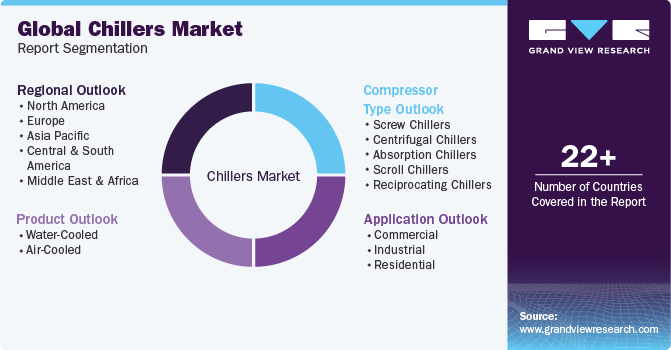
-
Product Outlook (Revenue, USD Million, 2018 - 2030)
-
Water-Cooled
-
<50kW
-
51-100kW
-
101-500kW
-
501-1000kW
-
1001-1500kW
-
>1501kW
-
-
Air -Cooled
-
<50kW
-
51-100kW
-
101-500kW
-
501-1000kW
-
1001-1500kW
-
>1501kW
-
-
-
Application Outlook (Revenue, USD Million, 2018 - 2030)
-
Commercial
-
Corporate Offices
-
Data Centers
-
Public Buildings
-
Mercantile & Service
-
Healthcare
-
Others
-
-
Industrial
-
Chemicals & Pharmaceuticals
-
Food & Beverage
-
Metal Manufacturing & Machining
-
Medical & Pharmaceutical
-
Plastics
-
Others
-
-
Residential
-
- Compressor Type Outlook (Revenue, USD Million, 2018 - 2030)
-
Screw Chillers
-
Centrifugal Chillers
-
Absorption Chillers
-
Scroll Chillers
-
Reciprocating Chillers
-
-
Regional Outlook (Revenue, USD Million, 2018 - 2030)
-
North America
-
U.S.
-
Canada
-
Mexico
-
-
Europe
-
UK
-
Germany
-
France
-
Italy
-
Spain
-
Russia
-
-
Asia Pacific
-
China
-
Japan
-
India
-
Australia
-
Thailand
-
South Korea
-
Indonesia
-
Malaysia
-
-
Central & South America
-
Brazil
-
Argentina
-
-
Middle East and Africa
-
Saudi Arabia
-
South Africa
-
UAE
-
-
Frequently Asked Questions About This Report
b. Some of the key players operating in the chillers market include Trane, Cold Shot Chillers, Tandem Chillers, Drake Refrigeration, Inc., Refra, Carrier, FRIGEL FIRENZE S.p.A., Midea, Rite-Temp, Multistack, LLC., DAIKIN INDUSTRIES, Ltd., General Air Product, ClimaCool Corp., Johnson Controls, Fluid Chillers, Inc.
b. Key factors that are driving the chillers market growth include the rising temperatures due to global warming are likely to drive the demand for cooling equipment. Increasing adoption of chillers owing to their ability to remove heat from the building and maintain internal temperature is anticipated to drive the market.
b. The global chillers market size was estimated at USD 9,928.3 million in 2023 and is expected to be USD 10,328.7 million in 2024.
b. The global chillers market, in terms of revenue, is expected to grow at a compound annual growth rate of 4.5% from 2024 to 2030 to reach USD 13,457.0 million by 2030.
b. Asia Pacific region dominated the market and accounted for 45.5% share in 2023. The rising number of data centers in the region is anticipated to have a positive impact on the chillers market growth over the forecast period.
Share this report with your colleague or friend.
![gvr icn]()
NEED A CUSTOM REPORT?
We can customize every report - free of charge - including purchasing stand-alone sections or country-level reports, as well as offer affordable discounts for start-ups & universities. Contact us now
![Certified Icon]()
We are GDPR and CCPA compliant! Your transaction & personal information is safe and secure. For more details, please read our privacy policy.
We are committed towards customer satisfaction, and quality service.
"The quality of research they have done for us has been excellent."





